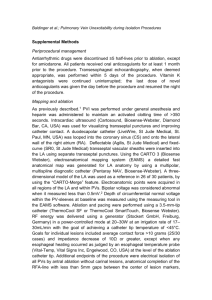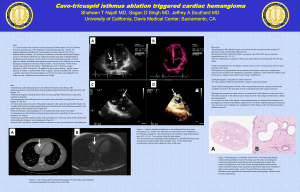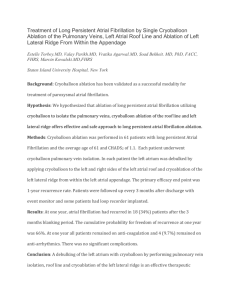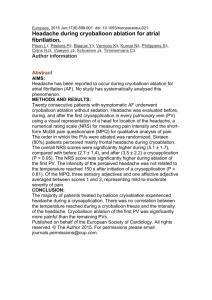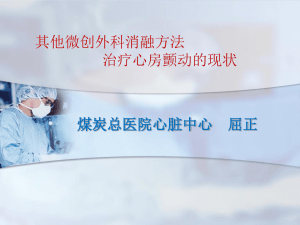EP_cases_guide
advertisement
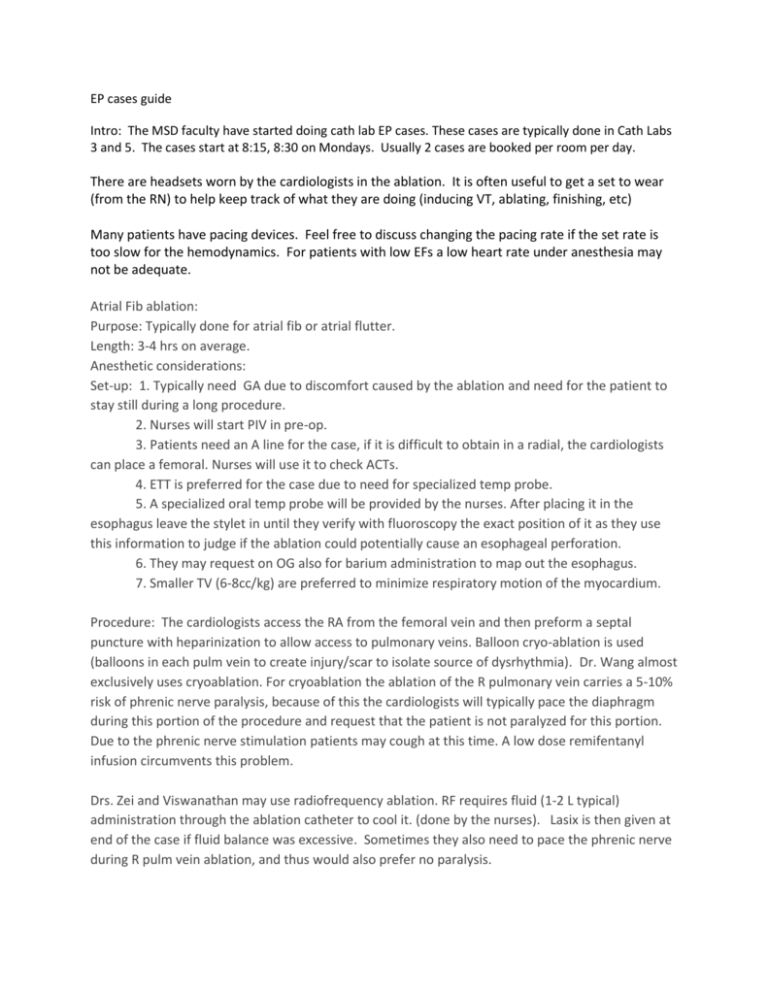
EP cases guide Intro: The MSD faculty have started doing cath lab EP cases. These cases are typically done in Cath Labs 3 and 5. The cases start at 8:15, 8:30 on Mondays. Usually 2 cases are booked per room per day. There are headsets worn by the cardiologists in the ablation. It is often useful to get a set to wear (from the RN) to help keep track of what they are doing (inducing VT, ablating, finishing, etc) Many patients have pacing devices. Feel free to discuss changing the pacing rate if the set rate is too slow for the hemodynamics. For patients with low EFs a low heart rate under anesthesia may not be adequate. Atrial Fib ablation: Purpose: Typically done for atrial fib or atrial flutter. Length: 3-4 hrs on average. Anesthetic considerations: Set-up: 1. Typically need GA due to discomfort caused by the ablation and need for the patient to stay still during a long procedure. 2. Nurses will start PIV in pre-op. 3. Patients need an A line for the case, if it is difficult to obtain in a radial, the cardiologists can place a femoral. Nurses will use it to check ACTs. 4. ETT is preferred for the case due to need for specialized temp probe. 5. A specialized oral temp probe will be provided by the nurses. After placing it in the esophagus leave the stylet in until they verify with fluoroscopy the exact position of it as they use this information to judge if the ablation could potentially cause an esophageal perforation. 6. They may request on OG also for barium administration to map out the esophagus. 7. Smaller TV (6-8cc/kg) are preferred to minimize respiratory motion of the myocardium. Procedure: The cardiologists access the RA from the femoral vein and then preform a septal puncture with heparinization to allow access to pulmonary veins. Balloon cryo-ablation is used (balloons in each pulm vein to create injury/scar to isolate source of dysrhythmia). Dr. Wang almost exclusively uses cryoablation. For cryoablation the ablation of the R pulmonary vein carries a 5-10% risk of phrenic nerve paralysis, because of this the cardiologists will typically pace the diaphragm during this portion of the procedure and request that the patient is not paralyzed for this portion. Due to the phrenic nerve stimulation patients may cough at this time. A low dose remifentanyl infusion circumvents this problem. Drs. Zei and Viswanathan may use radiofrequency ablation. RF requires fluid (1-2 L typical) administration through the ablation catheter to cool it. (done by the nurses). Lasix is then given at end of the case if fluid balance was excessive. Sometimes they also need to pace the phrenic nerve during R pulm vein ablation, and thus would also prefer no paralysis. Risks: include cardiac perforation/ tamponade, esophageal injury/bleeding, airway bleeding from pulm vein injury (rare). If new hemodynamic instability or narrowing of the pulse pressure presents, notify the cardiologist so they can use their intra-atrial US to evaluate for tamponade. In case of tamponade: Nurses will obtain a pericardiocentesis tray. They stop the procedure. Heparin is reversed with protamine. They call an interventional cardiologist from Cath 6. Interventional cardiologist places a pigtail catheter into the pericardium to drain the tamponade. They watch the patient, if further drainage is required, they call CT surgery. The nurses should know who is on for both CT surgery and interventional cardiology before the start of the case. SVT Ablation: May be done under GA or MAC depending on the case. Cases typically last 3-4 hrs. Many SVTs are abolished by GA and so limited sedation is preferred, especially during mapping. The first part of the case involves mapping of the myocardium to identify scar and culprit tissue that is initiating the dysrhythmia-light sedation with agents like Dex or just versed is preferred. Sometimes the cardiologists will inject isoproterenol in an attempt to induce the arrhythmia. Unfortunately any movement of the patient during the mapping, ruins the orientation of the map and may require remapping. SVT can be right-sided or left-sided. Left-sided requires septal puncture and heparinization. For left sided lesions frequently a radial Aline and GA are needed. Although LMAs can be fine, sometimes ETT provide better airway control. Also mechanically ventilation (low TVs) allows for control of respiratory motion when needed. Risks are same as for A fib ablations, tamponade being top of the list. VT Ablation: Generally GA is preferred, unless VT is particular difficult to provoke then occasionally MAC is requested, again Dex if tolerated is the preferred agent to provide optimal provoking conditions. However, these can be long cases, up to 6hrs in some cases. Patients frequently have poor cardiac function and low EFs. A line is usually needed, as VT is being induced, and BP monitoring becomes important. Avoid fluid overload. If EF is low patients may need inotropic support (dopamine or low dose epi drip). If EF is normal (eg RV dysplasia) could use phenylephrine gtt, but be aware of low cardiac output given prolonged VT needed for map (follow pulse pressure, UOP, etc). Risks: VF arrest (nurses always put on defib pads, cardiologist will defibrillate the patient either with external or internal device). Our goal is to support patient if defibrillation is unsuccessful (usually it is after 2nd shock if first was not). Epi (usually 50-100mcg rather than code dose), Vaso (5-10 units), only if pt is not responding to defib or epi. Perforation/tamponade again are also possible complications. Pacemaker placement ("2 chamber": RA and RV lead): Generally can be done without anesthesia or under MAC sedation unless there is a specific patient need/consideration eg: anxiety or high BMI. Any anesthesia you deem appropriate for the patient is fine. Occasionally they will need to test high output pacing and make sure it does not stimulate the phrenic nerve, thus no paralysis is preferred. ICD placement: Theoretically can be done without anesthesia or with MAC. Only need brief GA for defibrillator threshold testing (DFT testing) (ie. induction of VF and defibrillation at different energy levels). Currently DFT testing is becoming less common, especially in the setting of ICD for primary prevention (eg pt with low EF or HOCM but no VF arrest). These patients frequently have poor cardiac function. Again be careful with fluid administration. BiVentricular Pacemaker/ICD: Like standard ICD plus a 3rd lead is placed retrograde into the coronary sinus. This lead is threaded retrograde into a branch coronary vein to allow direct stimulation of the LV. GA is preferred, given length of time it takes to position ICD lead. On average this takes 2-3 hrs. A line is preferred because most patients have low EFs and a conduction delay. Other: There is a population of patients with mitochondrial diseases and congenital heart diseases that occasionally come through the cath lab. They are starting to expand their adult congenital volume, however for now the cardiac anesthesia group will continue to be involved in these cases. Choice of agent: Very little evidence exists on the role of individual drugs on EP procedures. A combination of multiple drugs is generally used in a single patient, making strong conclusions difficult. Many agents including fentanyl, ketamine, dexmedetomidine, midazolam, isoflurane and sevoflurane have been used safely in these procedures. Lidocaine is not a good agent to use in these procedures. Neither propofol nor isoflurane anesthesia altered sinoatrial node or AV node function in pediatric patients undergoing RFA. (3) Most tachyarrhythmias remained inducible under propofol anesthesia, except for ectopic atrial tachycardia in children that were not inducible in 4 out of 7 children and the procedure could not be accomplished.(4) For Wolff-Parkinson-White ablation, sufentanil-lorazepam had no clinically significant effect on the EP expression of the accessory pathway, however volatile anesthetics, with enflurane and isoflurane being most significant, increased refractoriness of the accessory and AV pathways. (5) Further Reading: 1. Ashley EMC. Anaesthesia for electrophysiology procedures in the cardiac catheter laboratory. Continuing Education in Anaesthesia, Critical Care & Pain. 2012. 2. Anderson R, Harukuni I, Sera V. Anesthetic Considerations for Electrophysiologic Procedures. Anesthesiology Clinics, Volume 31, Issue 2, June 2013, Pages 479-489 3. Lai LP, Lin JL, Wu MH, et al. Usefulness of intravenous propofol anesthesia for radiofrequency catheter ablation in patients with tachyarrhythmias: infeasibility for pediatric patients with ectopic atrial tachycardia. Pacing Clin Electrophysiol. 1999;22: 4. . 5. 6. 1358–1364. Lavoie J, Walsh EP, Burrows FA, et al. Effects of propofol or isoflurane anesthesia on cardiac conduction in children undergoing radiofrequency catheter ablation for tachydysrhythmias. Anesthesiology. 1995;82:884–887. Sharpe MD, Dobkowski WB, Murkin JM, et al. The electrophysiologic effects of volatile anesthetics and sufentanil on the normal atrioventricular conduction system and accessory pathways in Wolff-Parkinson-White syndrome. Anesthesiology. 1994;80: 63–70 V. Malladi, P.S. Naeini, M. Razavi, C.D. Collard, J.M. Anton, D.A. Tolpin, Endovascular ablation of atrial fibrillation, Anesthesiology, 120 (2014) 1513-1519.

